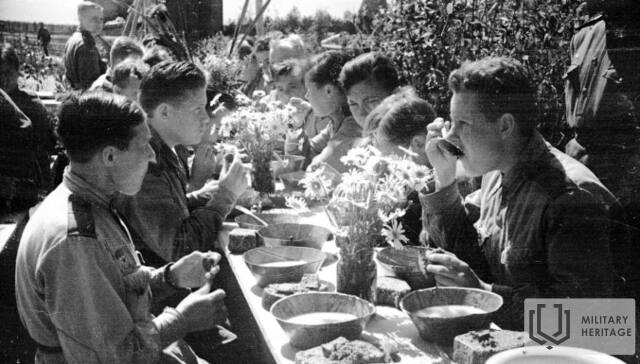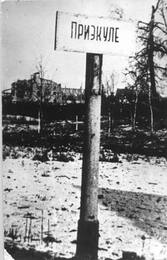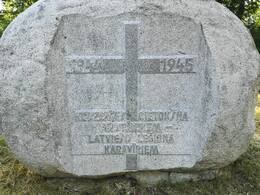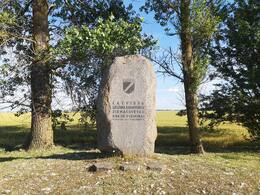Testimony of Jūlijs Bērziņš about the 201st (43rd Guards) Latvian Rifle Division of the Red Army in 1942-1945

In the fall of 2011, I came across the memoirs of Jūlijs Bērziņš (1900–after 1963), a Latvian living in Russia and a former soldier of the 201st (43rd Guards) Latvian Rifle Division (hereinafter – the 201st Latvian Rifle Division; Division) of the Red Army – a 189-page story written by hand in Russian in two lined notebooks by a Latvian soldier about his experiences in the German-USSR war (1941–1945). These memoirs were also not commissioned work.
From 23 to 28 December 1944, the 130th Latvian Rifle Corps fought in battles near Džūkste against the 19th Division of the Latvian Legion. On 31 December, battles followed in the vicinity of Kārmači, then in February 1945, battles near Zvārde, in March 1945, the 130th Latvian Rifle Corps was placed in reserve. It was concentrated in Blīdene (near Saldus) and the wider area, where regular battles took place in March. It should be noted that the battle near Blīdene, which began on 4 March, can be described as “hitting the wall with your forehead”. What had already begun in December 1941 during the battles for Moscow continued – Latvian soldiers were assigned to fight in a virtually hopeless sector of the front. The battles near Blīdene lasted a month.
On May 8, 1945 – the day the war ended, the 130th Latvian Rifle Corps was located on the banks of the Imula River.
In March 1947, the division was transformed into the 29th Separate Guards Latvian Riga Rifle Brigade, in June 1950 – into the 43rd Guards Latvian Rifle Riga Division, but in May–June 1956, the division and its units were disbanded.
In fact, the entire period of the 201st Latvian Rifle Division's fighting was characterized by both a lack of command personnel, and heavy losses of personnel on the battlefields and subsequent difficulties in replenishing them, especially with Latvian soldiers. This radically changed the national composition of the division, causing dissatisfaction among the division commanders, especially Veikins.
JULIA BĒRZINĀS' PERSONALITY
The only source of information about the person of Jūlijs Bērziņš is what he himself says about himself in his memoirs. Jūlijs Bērziņš is a Russian Latvian, probably born in Nizhny Novgorod (from 1932 to 1991 Gorky), where he lived until the moment of his conscription into the 201st Latvian Rifle Division. Probably born in the territory of Latvia and evacuated to Russia after the outbreak of World War I in 1914. Born in 1900. Participated in the Russian Civil War, however, it is not known for how long and in which sector of the front. Before the outbreak of the German-USSR war, he worked in Gorky in the Water and Sewerage Trust's economic department as an accountant. He was drafted into the Red Army on May 25, 1942, sent to the 1st Separate Latvian Riflemen Reserve Regiment, and after completing training, he was assigned to the 1st Battalion of the 191st Regiment of the 201st Latvian Riflemen Division, in the machine gun company. By the spring of 1943, Bērziņš had the rank of private; he may have been promoted during the war, as his memoirs mention the fact that he was the commander of an ammunition supply (platoon) at the end of the war. It is not clear from his memoirs whether he suffered during the repressions of 1937–1938 in Russia, and this is not confirmed by the databases of those arrested and punished during the political terror of the USSR. Bērziņš's possible connection with the repressions is evidenced by the open criticism of the events and consequences of 1937–1938, characteristic of his memoirs.
In September 1942, during the Battle of Tuganova, Bērziņš was wounded, after which he spent three months in military hospitals, until on December 15 of the same year he again ended up in the Gorohovec camp in the 1st Separate Latvian Rifle Reserve Regiment. After training, at the end of March 1943, he returned to the 201st Latvian Rifle Division, this time in the 121st Guards Latvian Rifle Regiment. There he was both in a machine gun company and was transferred (due to age) to a farm platoon, where he served until the end of the war. After the war, he lived in Moscow.
He began writing his memoirs in June 1942, and although he only mentions the years 1942 and 1943, the author also covers the events of 1944 and 1945. Bērziņš writes not only about events in which he was a participant, but also provides an assessment of the past. It is difficult to judge whether the author has a phenomenal memory or uses good books, but sometimes he provides a detailed insight into different stages of Russian history.
The memoirs are a new, previously unpublished testimony about the 201st Latvian Rifle Division and what they saw in the war. The value of the memoirs is determined by the author's generally objective judgments (they can be established alongside information in other sources, including official documents) and by details not found in other sources that supplement individual events. The memoirs provide a general picture of the situation in the division, when the outcome of the war was already known. This is indicated by the author's judgments about events in the past, or what actions should have been taken to have a different outcome.
For this publication, individual fragments of Bērziņš's memories have been selected and translated. The parts that describe "dry" military events are not included, but those that allow us to follow the observations of a "living" soldier in relationships are included: soldier - commander, soldier - other soldiers, soldier - duties, soldier - events.
Ilze Jermacāne "The Testimony of Julia Berzins" LVIZ 2012
https://www.lvi.lu.lv/fileadmin/user_upload/lu_portal/lvi.lu.lv/LVIZ_Numuri/2012_2/I_Jermacane_Julija_Berzina_liecibas_LVIZ_2012_2.pdf
'Latvians don't flinch under bullets' – what we know and don't know about Latvians in the Red Army - DELFI
https://www.delfi.lv/kultura/news/books/latviesi-lodem-neklanas-ko-mes-zinam-un-nezinam-par-latviesiem-sarkanja-armija.d?id=53232121
Your comments
Related objects
Kurzeme fortress museum in Zante
Will be open from May 1st.
Memorial Stone to Defenders of the Kurzeme Fortification
Located in Tukums region, on the side of the A9 highway, 500 m from the turnoff to Lesteni in the direction of Riga.
The memorial was established in 1991 near the Rumbu houses, which were the scene of active hostilities. It is a tribute to the defenders of the “Courland Fortress” who fought against the Red Army in World War II. The battles were significant because they temporarily halted the Red Army’s complete occupation of Latvia. Approximately 300,000 Latvians emigrated to escape the crimes committed against civilians by the Soviet regime.
At the end of World War II, a peculiar situation had developed in the territory of Latvia. German army forces were located in Courland, which the Red Army tried to eliminate or prevent from being involved in battles in East Prussia or around Berlin. “Courland Fortress” is the most common term used to describe the hostilities in Courland from 1944 to 1945. “The Battle of Courland” was the German army’s fight to repel the Red Army’s massive attacks. The Courland Fortress ceased to exist shortly after Germany’s capitulation.
Today, you can visit the memorial and resting place, which was popular among Latvian legionnaires since the restoration of Latvia's independence.
Monument to Victims of the Christmas Battles in Pienava
Located in Tukums region, on the side of the A9 highway, approximately a kilometer after Pienava in the direction of Liepāja.
The memorial is located on the site of the Third Battle of Courland, or the Christmas Battle, in 1944. At the end of World War II, a unique situation had developed in the territory of Latvia. There were German army forces in Courland, which the Red Army tried to eliminate or prevent from being involved in battles in East Prussia or around Berlin. “Courland Fortress” is the most common term used to describe the battles in Courland from 1944 to 1945. The “Courland Battle” was the German army’s military operations to repel the Red Army’s massive attacks. Latvian legionnaires also actively participated in the battles in Courland.
Today, you can visit the memorial site. The open fields of the area, without the oldest buildings, are witnesses to the war.









In general, there is a feeling that there are a lot of inventions and all sorts of things brought in, like rumors and something that appeared after the changes in the early 90s, when a negative attitude towards the Soviet past was already developing. I don’t see any value in such memories. However, the history of the 43rd Latvian Division interests me very much. My father Buikis Peteris was in the division from the very beginning of its formation and served until the end of 45. For the last 2 years I have been in the position of deputy. division commander for logistics, i.e. chief of division logistics. When I was 8 years old, I was in my father’s division at Baltezers-Adazi. I remember well how the soldiers were demobilized. The wounded were still being treated in the medical battalion, etc.